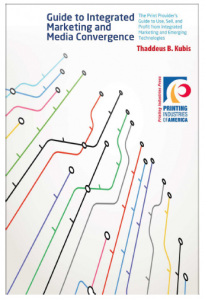Thaddeus Kubris is a fellow blogger on Printing Impressions, and an active member of my LinkedIn Group Print Production Professionals. Thad is extremely passionate about the evolution of communications, and recently authored a book to help Printers adapt and profit in the integrated media world.
I am still in the process of reading my copy, but I didn’t want my poor time management skills to stand in the way of sharing this information with you! So instead of writing a book review, I requested an interview, and Thad kindly agreed. ENJOY!!!
 DC: Who is Thaddeus Kubis and what does he do?
DC: Who is Thaddeus Kubis and what does he do?
TK: I am a dedicated life long adventurer and explorer of communications with a very strong passion for the print and printing segment of this complex vertical. I believe that print and media are a natural team that are changing, and this change will provide new profitable areas from which open-minded printers will benefit. On the personal side, I am a musician, artist, fine arts and editorial photographer, an experienced, passionate sailor and sailing instructor. Love to read science fiction, history and archaeology and long to learn a new fact each and every day. While reading and watching film noir, I have been known to sip a glass or wine or two based on the plot or genre of the movie.
“Sto imparando a parlare italiano”, and just saying I have been told that sailors enjoy rum as well!
On the professional side I am a graphic artist, designer, production and marketing professional, a teacher, lecturer, writer, an advocate and devotee of the convergence of media into a focused and valued tool for printers and marketers to use and to profit from. I support and advise both (actively and forensically) the B2B and B2C segments of the business world.
DC: Your new book is titled Guide to Integrated Marketing and Media Convergence… what is Media Convergence and why is it relevant to the print industry?
TK: True media convergence is a measured, planned integrated combination of the business of print, communications and marketing the three “C’s”, Communications, Content, and now the Cloud. If you add the Consumer (as the fourth “C”) you have Media Convergence, with a PhD. Printers could have adopted this new need and made it their own, had they only looked around at what was and is happening to the business of communications, not what was and is happening to printing.
 Printers can profit from media convergence if they remove their blinders, change their attitudes and realize that they are not the last stop or the last link on the chain of communication, but that they are an integral part of the chain supporting many links, profit based links, that now include the convergence and integration of media. I see print/printing morphing into integrated print joining forces with media convergence and offering services that will provide the knock out punch, with digital and emerging technologies leading the way and integrated print technologies supporting the knockout!
Printers can profit from media convergence if they remove their blinders, change their attitudes and realize that they are not the last stop or the last link on the chain of communication, but that they are an integral part of the chain supporting many links, profit based links, that now include the convergence and integration of media. I see print/printing morphing into integrated print joining forces with media convergence and offering services that will provide the knock out punch, with digital and emerging technologies leading the way and integrated print technologies supporting the knockout!
Print and printers need to stop being defensive and go on the offense and show their strengths, the ROI of print for one and how they with their process based experience can partner with their clients and embrace media convergence and integrated marketing,
DC: How is this book different, and what information does it provide, that cannot be found out there already?
TK: As far as I can tell there is not other book like this, I based this book on a year long study of printers and their client base, the tools the clients use as well as working with and for printers and enterprises for over 20 years. My book takes a very different twist; first my book offers one key source in which you can find a ton (ream) of information, knowledge, wisdom, valued and profit based data. After nearly each chapter there is a measurement scale to allow a printer to measure the difficulty or ease of introducing the tools mentioned for their own self-marketing needs and the needs of their clients. The data contained in the book which gets cold fast will be updated via a website I am developing. Access to this website will be offered (30 days free) to those that have purchased the book. The site will provide subject and topic updates, and will offer additions as needed, all based on my ongoing examination of the marketing needs of both printers and their clients.
DC: What is your advice for printers when it comes to helping customers see the value in cross-media and using it for their projects? And why is the adaption rate so slow?
TK: First answer ROI. The data is out there. Print when properly developed, added to or used to enhance a digital based marketing effort, can and will add to the positive results of nearly any project. Customer and prospects look for help, but the help needs to come from a relationship that is built on fundamentals of trusted advisor, honesty, fair pricing, profit advocacy and offering knowledge to share and services to use.
Second answer, FEAR! and a lack of knowledge that can be easily and effectively used to expand their business. Print providers need to stress integrated print as a valued and valid component of the marketing communications solution that their clients are searching for. Printers cannot be convincing, talk the talk, walk the walk, if they do not understand and use the very tools that they will be offering ,and their clients and prospects are demanding.
My book addresses both problems in many ways and offers solutions that each and every printer could use to speed the adaptation and expansion of their skill set.
DC: I was happy to see social media as a chapter in your book. What is one thing most printers get right, and one they mostly get wrong?
TK: Social media is to me a stepping-stone to yet to be found media that is slowly being developed. Messages do not make clients, communications do and that is where social media will need to go!
What printers do right and wrong is the same, they provide a great service, but those services are poorly presented, explained, sold and too often the effort to make it happens ends all to soon. I use a phrase when I speak to print based groups, “most printers develop a 30-day to go no where” marketing plan. Just when they will see the program gaining traction they give up, or they generate a limited amount of business and they shut the effort down. Printers also tend to hire sales people for new business, not a bad idea, but these sales teams need to be aware of the expanded chain of communication and must, yes MUST be looked at as components that need updates. Just like a press is updated to respond to a new need, sales team needs, management teams as well, need updating. My book provides a base and a solution to answer this need.
DC: If you were to give the commencement speech to UMASS Amherst on the future of print media + mobile media, how would you suggest printers start gearing up now?
TK: Ah, I see you checked out my LinkedIn profile!
I would suggest that printers need to look to get out of their own way, be more open minded, start to use the very communications tools that their clients use and that they produce for the communications vertical. They need to look (and learn) to the verticals they serve and find the common and not so common ground to establish dialogue and engagement based on those needs and use technology, tools and tactics that are supportive of the targeted vertical. Printing was once a sales only business, it is not longer such. It, as is everything else, is a multi-dimensional and complex support service undergoing daily change.
Presenting at UMASS or any other College would not be a speech, speeches, to me like buggy whips are gone!
I would present a highly interactive, experiential presentation announced via a printed personalized dimensional direct marketing kit sent to each graduate. Linked to a smart phone type response tool based on an app, this sensory based presentation would go live via a private internet network, using AR, IR, NFC and RIFD as well as sensory based clothing and a dynamic use of substrates.
The graduate would need to link to a personalized micro site to which they would use social media to interact with the speaker, members of the colleges, the dais, others and yes if needed their parents.
The presentation would be steaming live and advertising would be sold on the caps and gowns of those graduates, of which they would receive a commission.
An on demand day of event oriented print personalized programs would be offered to those attending. Products offered would be a personalized by student photo book, a historical retrospective of the years at the College and yes use technology like AR, digimarc and other interactive tools linking print to the Internet, and yes the entire event would be linked lived streaming to the Internet.
That is what and how I would do it!
Connect with Thad Kubis, Founder & Chief Integration Officer, The Institute For Media Convergence Web | LinkedIn | Twitter | Facebook | Email











